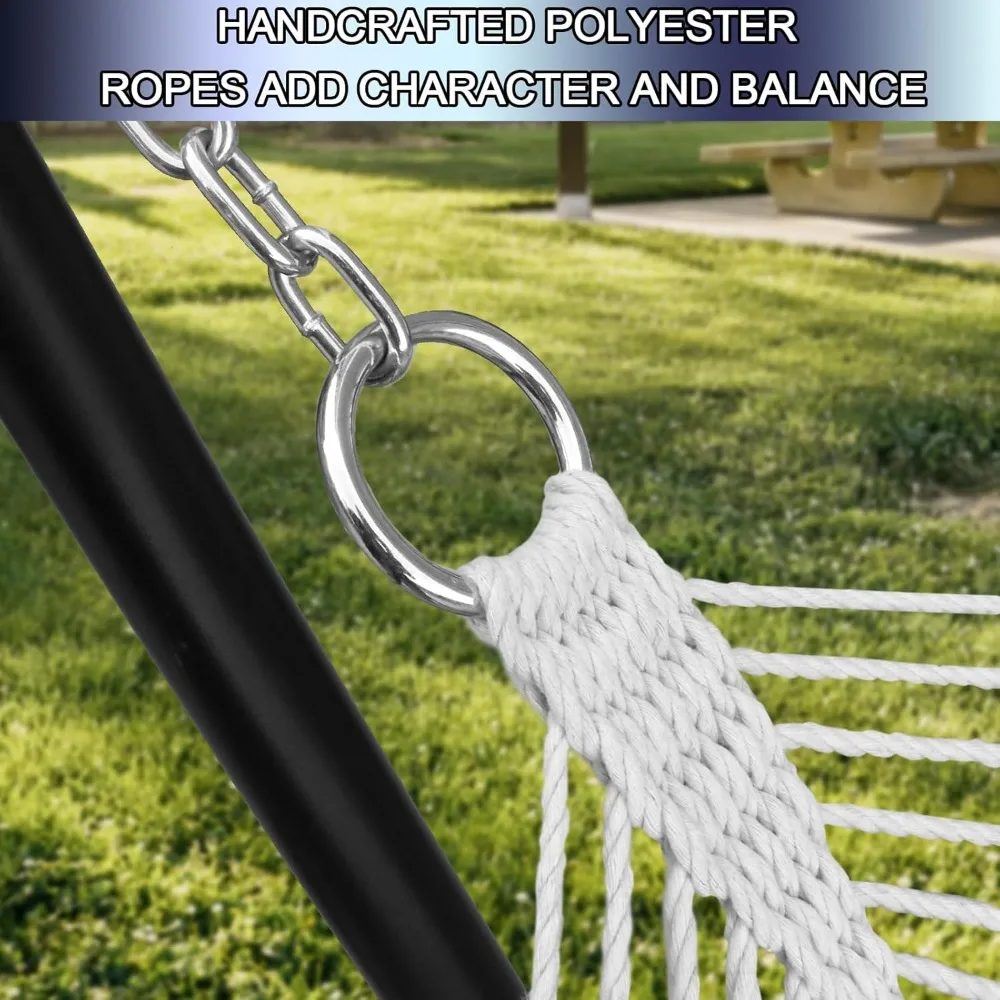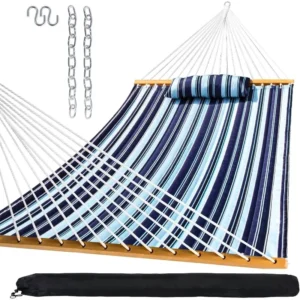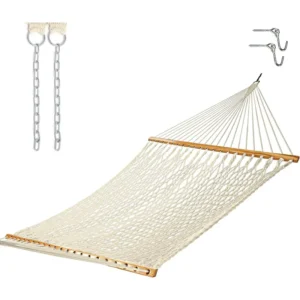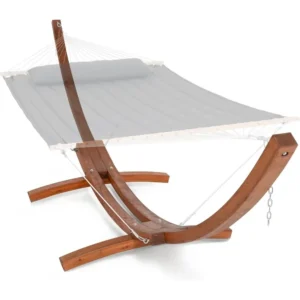When it comes to outdoor relaxation, few options can match the luxurious embrace of a quilted hammock. Unlike their simpler counterparts, quilted hammocks represent the pinnacle of comfort in the hammock world, offering a premium relaxation experience that combines plushness with practical design.
What sets quilted hammocks apart is their sophisticated layered construction. While standard hammocks provide basic support, quilted varieties elevate the experience with additional padding, structured support, and thoughtful design elements that work together to create an unparalleled resting place.
Throughout this article, we’ll explore the distinct comfort features that make quilted hammocks worth considering for your indoor-outdoor hammock placement needs. From pressure point relief to temperature regulation, even weight distribution to material quality, you’ll discover why relaxation enthusiasts consistently choose these premium options.
At Outside Luxe, we’ve extensively tested various hammock styles to understand what truly makes a difference in comfort. Our experience has shown that the unique qualities of quilted fabric hammock sets offer meaningful advantages for those seeking the ultimate in relaxation.
The Core of Comfort: Enhanced Padding and Pressure Point Relief
The foundation of quilted hammock comfort begins with their distinctive construction. Unlike single-layer hammocks, quilted varieties feature multiple fabric layers with padding materials sandwiched between them. This construction creates a fundamentally different resting experience.
The padding materials—typically polyester fill, cotton batting, or specialized foam—provide substantial cushioning that transforms how your body interacts with the hammock surface. This layered approach creates a buffer zone that absorbs and distributes pressure.
The science behind this pressure relief is straightforward yet effective. When you lie in a standard hammock, your body weight concentrates at specific points, particularly the shoulders, hips, and back. The padding in quilted hammocks creates a more forgiving surface that:
- Conforms to your body’s natural contours
- Prevents direct pressure from the supporting structure
- Eliminates the “rope imprint” common with traditional hammocks
- Creates a cushioned barrier between you and the hammock frame
Premium quilted hammocks typically feature padding thickness between 1-3 inches, providing substantial cushioning while maintaining structural integrity. This padding makes an immediate difference you can feel the moment you settle in, offering a gentle landing rather than the abrupt tension of unpadded surfaces.
The difference becomes particularly noticeable during extended relaxation sessions. While a standard hammock might become uncomfortable after 30 minutes, the enhanced padding in quilted vs non-quilted hammocks allows for hours of comfortable lounging without the need to constantly shift positions to relieve pressure points.
Year-Round Coziness: Temperature Regulation and Insulation
One of the most significant yet often overlooked benefits of quilted hammocks is their superior temperature management capabilities. The same layered design that provides cushioning creates natural insulation that extends hammock season well beyond summer months.
Cold Weather Comfort
Traditional hammocks have a common problem known as “cold butt syndrome” where your body heat escapes through compressed insulation, leaving you uncomfortably chilly. Quilted hammocks solve this problem through:
- Multiple fabric layers that trap warm air between them
- Insulating fill materials that create a thermal barrier
- Reduced airflow against your body’s underside
- Elimination of direct contact with cold supporting elements
This insulation effect works similarly to quilted bedding, creating air pockets that maintain warmth. Many users report comfortably using their quilted hammocks in temperatures as low as 50°F (10°C) without additional blankets or underquilts.
Warm Weather Benefits
Contrary to what you might expect, quilted hammocks can also enhance comfort in warmer conditions:
- The padding creates a buffer against hot surfaces that might otherwise absorb and radiate heat
- Premium quilted fabrics often feature moisture-wicking properties
- The structured design allows for better air circulation than fully-enclosing hammock styles
- The padding prevents the “sticky” feeling of direct contact with synthetic materials in heat
This temperature versatility makes quilted hammocks an excellent investment for year-round use, adapting to changing seasons while maintaining comfort levels that single-layer hammocks stands with basic hammocks simply cannot match.
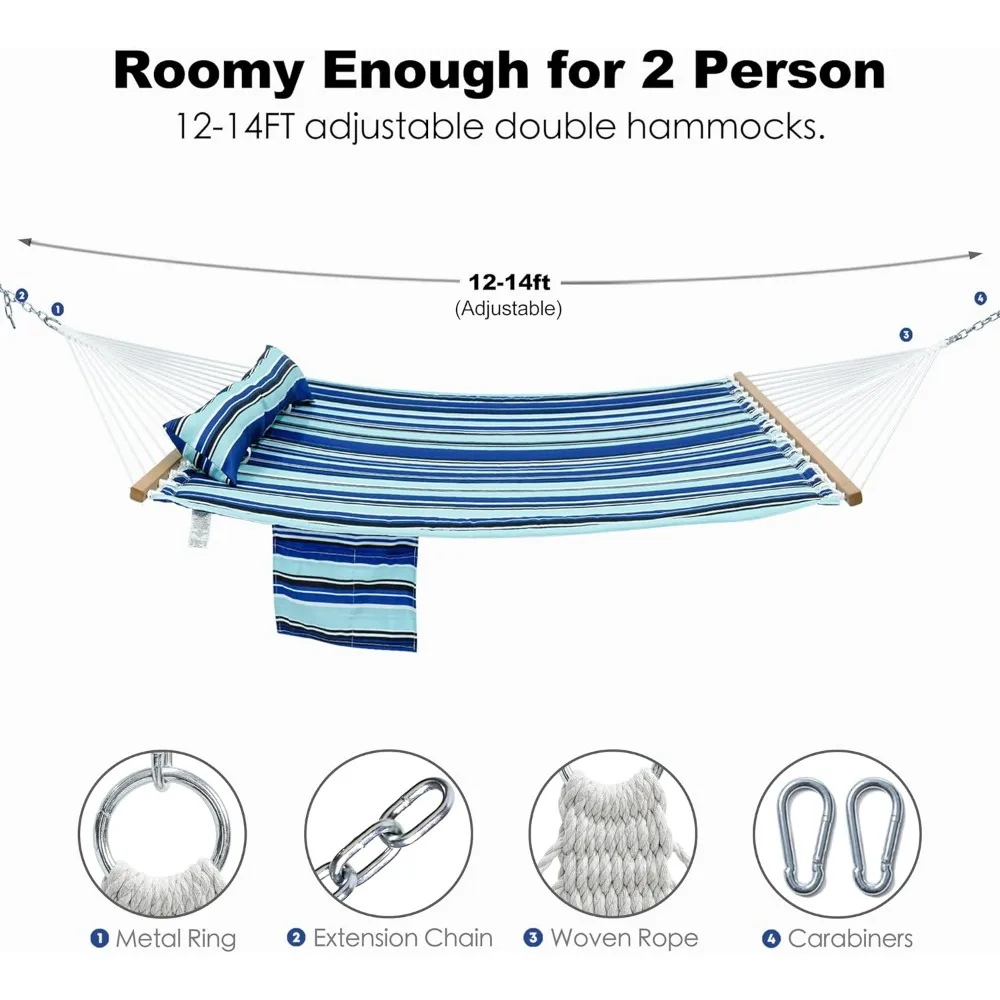
Unwavering Support: Even Weight Distribution for Blissful Relaxation
The distinctive flat lay of a quality quilted hammock isn’t just about aesthetics—it fundamentally changes how your body is supported during rest. This even weight distribution represents one of the most significant comfort advantages over traditional hammock designs.
Most quilted hammocks incorporate spreader bars—rigid supports at each end that maintain the fabric’s open, flat position. This design element works synergistically with the quilted construction to:
- Prevent excessive sagging in the middle of the hammock
- Eliminate the restrictive “cocoon effect” common in gathered-end hammocks
- Create a broader, more accommodating resting surface
- Allow for various comfortable positions beyond just the curved center lay
The quilting itself plays a crucial role in structural support. The stitching patterns that create the characteristic quilted appearance also segment the fill material, preventing it from shifting or bunching. This ensures consistent support across the entire hammock surface.
For those who find traditional hammocks uncomfortable due to the forced center position, spreader bar hammock sets with quilted fabric offer a liberating alternative. You can stretch out fully, lie diagonally, or even sit upright without fighting against the hammock’s natural tendency to enfold you.
This balanced support becomes particularly valuable during longer relaxation sessions, where being forced into a single position would become uncomfortable over time. The ability to adjust and reposition while maintaining comfort truly sets quilted hammocks apart for serious relaxation enthusiasts.
Stability and Security: A Hammock You Can Trust
Beyond pure comfort, quilted hammocks excel in providing something equally important to relaxation: a sense of security. Many people avoid traditional hammocks due to their reputation for being “tippy” or unstable. Quilted hammocks address these concerns through thoughtful design elements.
The combination of spreader bars, substantial fabric weight, and structured construction creates a remarkably stable lounging platform. This stability manifests in several ways:
- Reduced side-to-side rocking when getting in and out
- Minimal unexpected movement when shifting positions
- Greater resistance to tipping even with off-center weight
- More predictable behavior for first-time hammock users
This stability translates directly to psychological comfort—the ability to truly relax without constantly managing your balance or worrying about sudden movements. Understanding the proper hammock installation requirements safety guide further enhances this security.
The robust construction of premium quilted hammocks also supports generous weight capacities, typically between 400-600 pounds for two-person models. This capacity isn’t just about accommodating different body types—it represents overbuilt durability that provides peace of mind during use.
The security advantages extend to practical considerations as well. The stable platform makes everyday activities like reading a book, enjoying a beverage, or using a mobile device much more manageable than in swaying, unstable hammock varieties.
The Feel of Luxury: Material Softness and Lasting Durability
The tactile experience of relaxing in a quilted hammock represents a significant aspect of their comfort appeal. Premium quilted hammocks feature carefully selected fabrics that enhance both the immediate sensory experience and long-term durability.
Common materials in high-quality quilted hammocks include:
- Spun polyester with high thread counts for softness and weather resistance
- Cotton-polyester blends that combine natural feel with durability
- Solution-dyed Olefin fabrics that maintain color while resisting environmental damage
- DuraCord and other specialized synthetic fabrics designed specifically for outdoor comfort
These premium materials create a surface that feels pleasant against bare skin—important for hammocks that often make direct contact with arms, legs, and other exposed areas. The best fabric types quilted hammocks balance softness with practical concerns like UV resistance and moisture management.
Beyond the immediate feel, quality materials ensure that comfort doesn’t degrade over time. Premium quilted hammocks maintain their softness and supportive properties through:
- Fade-resistant dyes that prevent harsh, brittle fabric development
- Mildew-resistant treatments that preserve fabric integrity
- Reinforced stitching that prevents comfort-reducing stretching or sagging
- Quick-drying properties that prevent moisture damage
Many quilted hammocks also feature removable, washable covers or easy-clean surfaces that allow for simple maintenance without sacrificing the plush comfort that makes them special.
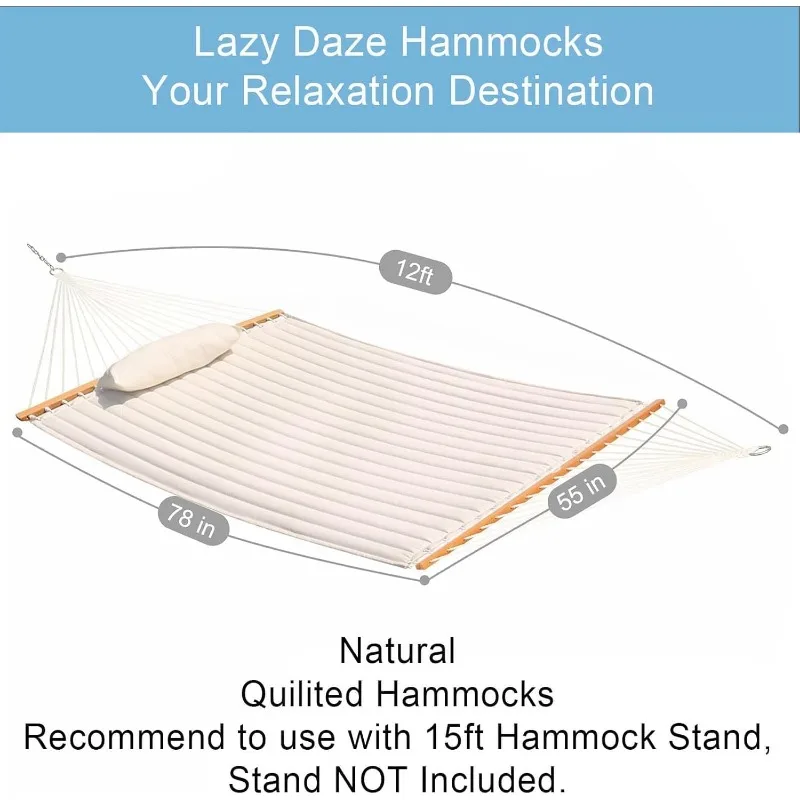
Quilted Hammocks vs. Other Styles: The Comfort Champion
To truly appreciate quilted hammock comfort, it helps to understand how they compare directly to other popular styles. Each hammock type offers distinct advantages, but quilted options consistently excel in comfort-focused comparisons.
Quilted vs. Rope Hammocks
Traditional rope hammocks have charm and heritage, but their comfort limitations become apparent when compared to quilted alternatives:
- Pressure Distribution: Rope creates pattern imprints on skin; quilted surfaces provide even contact
- Weather Adaptability: Rope offers minimal insulation; quilting creates temperature buffers
- Surface Feel: Rope texture can be rough or uneven; quilted fabric offers consistent softness
- Getting In/Out: Rope requires careful balance; quilted designs with spreader bars offer more stability
While rope hammock sets have their place in certain aesthetic settings, they simply can’t match the body-cradling comfort of a quality quilted option.
Quilted vs. Parachute/Nylon Hammocks
Lightweight backpacking hammocks made from parachute nylon offer portability but sacrifice several comfort elements:
- Insulation: Thin nylon transfers cold/heat easily; quilted layers provide thermal barriers
- Surface Structure: Nylon conforms completely to body contours; quilted hammocks offer supportive structure
- Size & Layout: Parachute styles encourage cocoon positioning; quilted designs allow flat, diagonal lay
- Sensory Experience: Nylon can feel slippery or clingy; quilted fabrics provide pleasant textile feel
Quilted vs. Single-Layer Fabric Hammocks
Even when comparing fabric to fabric, the quilted construction makes a meaningful difference:
- Cushioning: Single-layer fabric provides minimal padding; quilted construction creates genuine cushioning
- Weight Distribution: Basic fabric hammocks develop pressure points; quilted designs spread weight evenly
- Temperature Management: Single layers transfer ambient temperature; quilted layers regulate it
- Long-Term Comfort: Basic hammocks become uncomfortable after short periods; quilted options support extended relaxation
These comparisons highlight why quilted hammocks justify their premium positioning—they consistently address the comfort limitations that cause people to abandon other hammock styles.
A-Frame Stand Hammock Sets, Swinging Hammock Chair Sets
$154.62 Select options This product has multiple variants. The options may be chosen on the product pageClassic Wooden Stand Hammock Sets, Heavy Duty Hammock Sets
$1,061.68 Select options This product has multiple variants. The options may be chosen on the product pageHammock Sets with Canopy, Heavy Duty Hammock Sets
$286.31 Select options This product has multiple variants. The options may be chosen on the product pageDouble / Two Person Hammock Sets, Rope Hammock Sets
Double Traditional Cotton Rope Hammock with Extension Chains – 450 lbs Capacity for Backyard & Patio$292.98 Select options This product has multiple variants. The options may be chosen on the product pageHeavy Duty Hammock Sets, Wooden Arc Stand Hammock Sets
$878.66 Select options This product has multiple variants. The options may be chosen on the product page
Solving Common Hammock Discomforts with Quilted Design
Many people have tried hammocks only to abandon them due to specific discomforts. The quilted design directly addresses these common pain points in ways that transform the hammock experience:
Back Strain Solution
Traditional hammocks can create an exaggerated curve in the spine, leading to discomfort. Quilted hammocks with spreader bars allow for flatter positioning that maintains better spinal alignment, reducing strain during extended use.
Claustrophobia Relief
The enveloping wrap of parachute-style hammocks creates an enclosed feeling that many find uncomfortable. Quilted designs maintain an open, accessible space with visible surroundings and freedom of movement that eliminates this sensation.
Temperature Management
The direct contact with outside air in basic hammocks leads to rapid heat loss. Quilted construction creates insulating layers that regulate temperature, eliminating the need for additional underquilts or blankets in mild conditions.
Pressure Point Elimination
Basic hammocks concentrate weight at the hammock’s lowest point. Understanding the perfect hammock depth lounging comfort helps appreciate how quilted hammocks distribute pressure more evenly across their padded surface.
Movement Freedom
Single-position restrictions in traditional hammocks cause stiffness over time. Quilted hammocks with their broader, more stable surface allow for position changes and movement without compromising comfort or stability.
These solutions don’t just make quilted hammocks marginally better—they fundamentally transform the hammock experience for people who previously found hammock lounging uncomfortable or impractical.
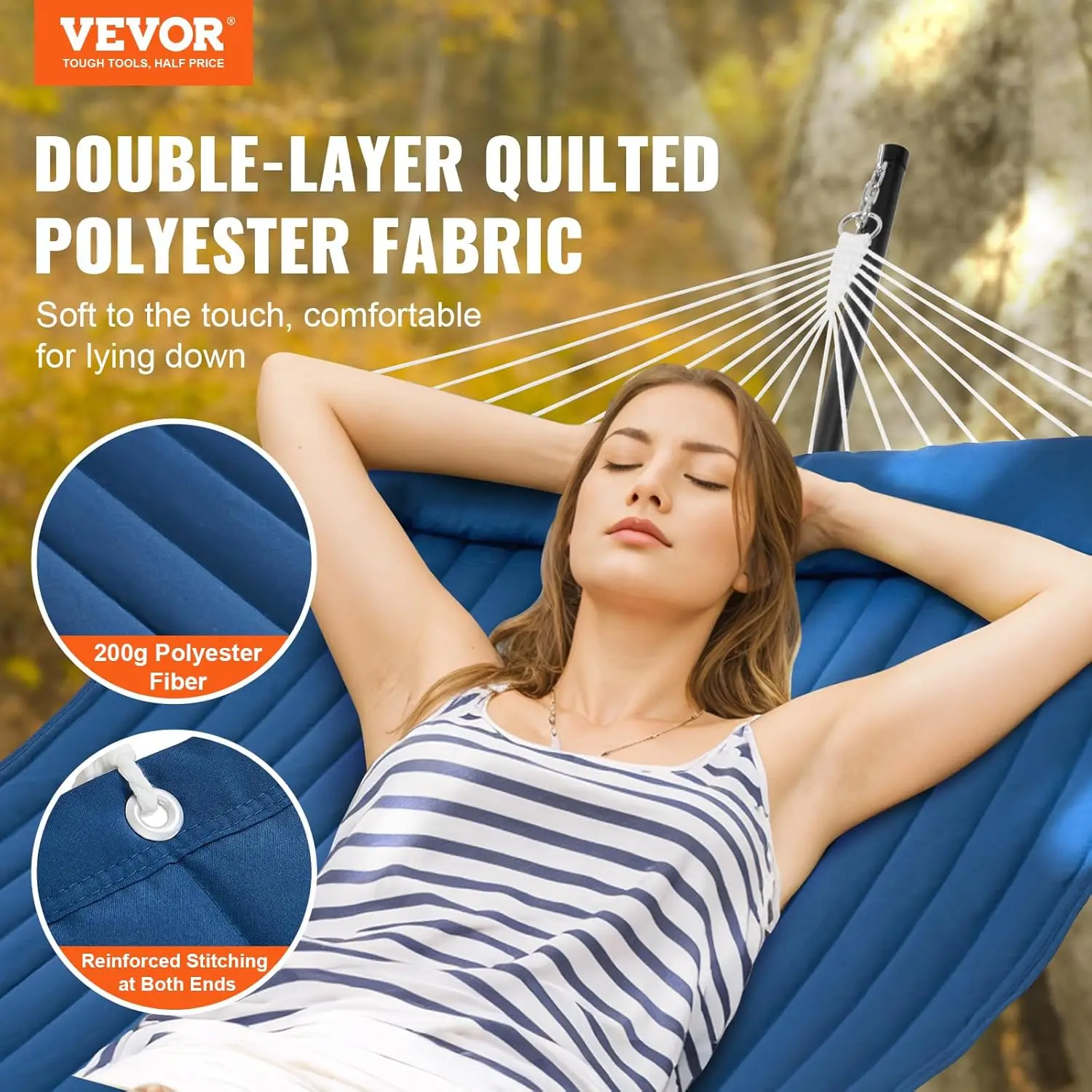
Is a Quilted Hammock Your Perfect Comfort Solution?
After exploring the comprehensive comfort benefits of quilted hammocks, it’s worth considering whether this premium option aligns with your relaxation needs. Quilted hammocks particularly excel for:
- Those seeking extended comfort for reading, napping, or prolonged relaxation
- People who have found traditional hammocks uncomfortable or unstable
- Anyone wanting to extend hammock season beyond warm summer months
- Households where the hammock will serve as a primary outdoor relaxation spot
- Those who prioritize both aesthetic appeal and functional comfort
- Individuals with sensitivity to pressure points or temperature fluctuations
The value proposition of quilted hammocks centers on transforming occasional hammock use into a regular comfort ritual. While the initial investment exceeds basic hammock options, the extended usability and enhanced enjoyment justify the premium for many users.
The quilted hammock’s unique combination of padding, support, stability and temperature management creates a genuinely different experience—one that often converts hammock skeptics into enthusiasts. For optimal placement, consider these best indoor outdoor hammock locations for your quilted comfort retreat.
How to Maximize Your Quilted Hammock Comfort Experience
To get the most from your quilted hammock investment, consider these practical enhancement strategies:
Optimal Hanging Techniques
- Position your hammock with a 30-35 degree angle from the hanging points for ideal sag
- Maintain approximately 18 inches of height at the center when weighted
- Ensure equal tension on both sides for balanced support
- Allow sufficient space around the hammock for gentle movement
Complementary Accessories
- Add coordinating hammock pillows for head and neck support
- Consider a side table for convenient access to books or beverages
- Install a canopy or umbrella for shade protection on sunny days
- Use weather-resistant storage bags to protect your hammock when not in use
Position Variations
- Try lying diagonally across the hammock for the flattest positioning
- For reading, create a slight incline by adjusting one end higher
- For star-gazing, center yourself with minimal head elevation
- For conversation, sit sideways with legs over the edge for an upright position
Maintenance Practices
- Brush off debris regularly to prevent fabric abrasion
- Follow manufacturer guidelines for cleaning specific fabric types
- Store in dry conditions during extended non-use periods
- Inspect hardware and connection points periodically for wear
By combining quality fabric hammock sets with these practical tips, you’ll create a comfort oasis that becomes a favorite retreat for years to come. The quilted hammock experience represents outdoor relaxation at its finest—an investment in genuine comfort that pays dividends with each use.

